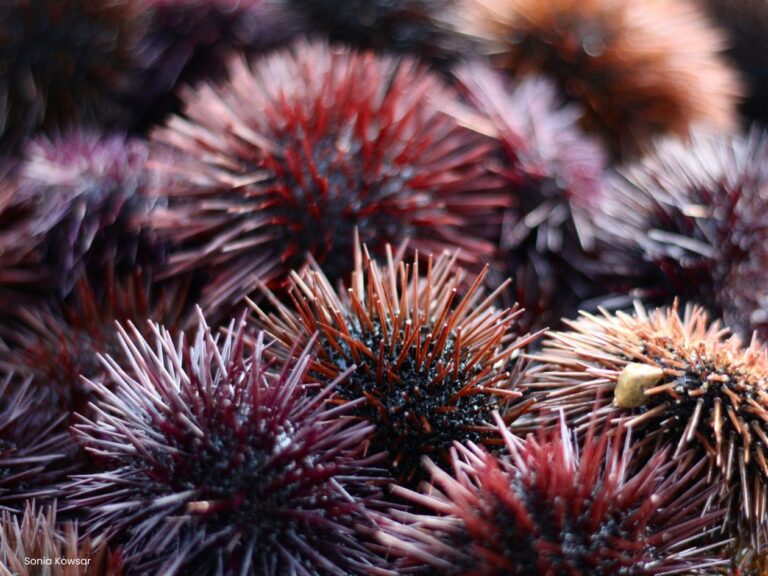How BC’s Urchin Fishery Could Play a Role in Kelp Restoration
TLDR
Sea urchins are an economically and culturally important species on B.C.’s coast. In many areas their populations have exploded, stripping away kelp forests and leaving behind barren seascapes. Because only well-fed urchins produce valuable uni, today’s fishery rarely targets these overgrown “zombie” urchins. A promising path forward is to feed urchins in place using surplus farmed kelp, aligning economic incentives with ecological restoration.

What urchins do in BC's Kelp forests?
Along much of British Columbia’s coast, the balance between kelp and urchins has tipped. With fewer predacious sea otters and sunflower sea stars, urchins have multiplied unchecked, consuming kelp faster than it can regrow. The result: wide stretches of “urchin barrens” where once-thriving kelp forests have vanished. In these barrens, the seafloor lies stripped bare, a crust of rock and scattered urchins where little else survives.
Urchins have always been part of coastal life in B.C. They are a natural component of the ecosystem and an important traditional food. On the west coast of Vancouver Island, the Nuu-chah-nulth peoples call urchins tučup, reflecting thousands of years of harvest and cultural use.
When the balance broke
The ecological imbalance we see today traces back to two key losses in the food web. The first began with the maritime fur trade of the 18th and 19th centuries, when sea otters were hunted nearly to extinction along the North Pacific coast. Without otters to keep them in check, urchin numbers exploded. The second came more recently with the outbreak of sea star wasting disease, which devastated populations of the sunflower sea star (Pycnopodia helianthoides), another major urchin predator. With both controls gone, urchins spread into kelp beds, consuming new growth before it could establish.
The transformation has been dramatic. In places that once supported dense canopies of bull kelp, only bare rock and scattered urchins remain. These barrens store less carbon, shelter fewer fish, and leave coastal ecosystems more exposed to warming and wave energy.

Linking Restoration with the Fishery
For decades, the urchin fishery has targeted uni—the golden roe inside well-fed urchins—prized in markets across Asia. Yet the urchins that most need to be removed are the least valuable. Starved “barren” urchins produce almost no roe, leaving fishers with no financial reason to harvest where the ecological benefits of removal would be greatest.
Turning this dynamic around will require aligning economic and ecological goals. If barren urchins could be made marketable, fishers could earn income while actively restoring kelp habitat. The question is how to make that possible.
Ranching vs. Feeding in Place
Some companies, such as Urchinomics, have tested this idea by collecting urchins from barrens and feeding them in land-based tanks until their roe quality improves. The results are promising but expensive, involving specialized infrastructure, transport, and feed.
A more practical approach may be to feed urchins where they live. By bringing kelp to the barrens rather than moving urchins to tanks, roe quality could be improved enough to support a viable harvest. This “in-situ feeding” concept would shift restoration from a cost centre to an opportunity—one that rewards removal in the very places where kelp recovery depends on it.
Feeding in Place
British Columbia’s emerging kelp farming sector could make this idea work. Farms often have surplus or trimmings that are difficult to sell. That material could become feed for nearby barren urchins, creating a local restoration loop:
Kelp farms supply surplus biomass → urchins are conditioned in place → fishers harvest market-ready urchins → kelp has space to regrow.
Delivering kelp efficiently to the seafloor remains the main challenge. Weighted bundles, degradable crates, or simple deployment methods could be tested, but logistics and labour costs will determine whether the model scales.
A Pilot Project Worth Testing
A small pilot could help test whether this approach is viable:
- Identify sites where barrens border healthy kelp beds and are accessible to vessels and farms.
- Partner with nearby farms to source surplus kelp under biosecure handling conditions.
- Feed urchins in place using simple, retrievable setups.
- Monitor changes in roe colour, texture, fill, and yield over several weeks.
- Harvest and compare results with unfed control sites.
Restoration partners could track ecological indicators such as kelp recovery and urchin density, while fishers measure roe yield and market acceptance.
If the data support it, this approach could turn barren seafloors into sites of both recovery and livelihood, a rare case where ecology and economy move in the same direction.
Partner with West Coast Kelp to co-design a small, measurable pilot that tests in-situ urchin feeding as a restoration tool.
